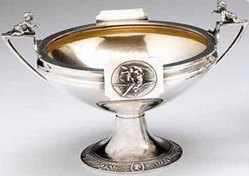 “Vermeil” is a French word co-opted by the English in the 19th century for a silver gilt process. Vermeil is a combination of silver and gold, although other precious metals are also occasionally added, that is then gilded onto a sterling silver object. The reddish (vermilion) hue of the addition of the gold gives the product its name. Vermeil is commonly found in jewelry, silver tablewares, and small decorative objects and a standard of quality (10 karat gold) and thickness (1.5 micrometers) has been set with regard to jewelry.
“Vermeil” is a French word co-opted by the English in the 19th century for a silver gilt process. Vermeil is a combination of silver and gold, although other precious metals are also occasionally added, that is then gilded onto a sterling silver object. The reddish (vermilion) hue of the addition of the gold gives the product its name. Vermeil is commonly found in jewelry, silver tablewares, and small decorative objects and a standard of quality (10 karat gold) and thickness (1.5 micrometers) has been set with regard to jewelry.
Vermeil was initially created through fire or mercury gilding, a technique developed in the 18th century, which requires the application of a solution of mercury nitrate to the object and then the application of a silver and gold/mercury amalgam. In order for the gilding to adhere to the surface, the coated object is placed in a kiln and exposed to extreme temperatures, which burns away the mercury. (This is similar to the technique used to produce ormolu, a form of gold-gilt.) As a result of the intense and prolonged exposure to mercury, it has been estimated that most mercury gilders died before the age of 40. Mechanical or chemical gilding techniques were largely replaced by electroplating by the mid-19th century, and the process was banned in many countries in the mid-1800s.
The White House has a room known as the Vermeil Room, so named for a collection of vermeil tableware.



